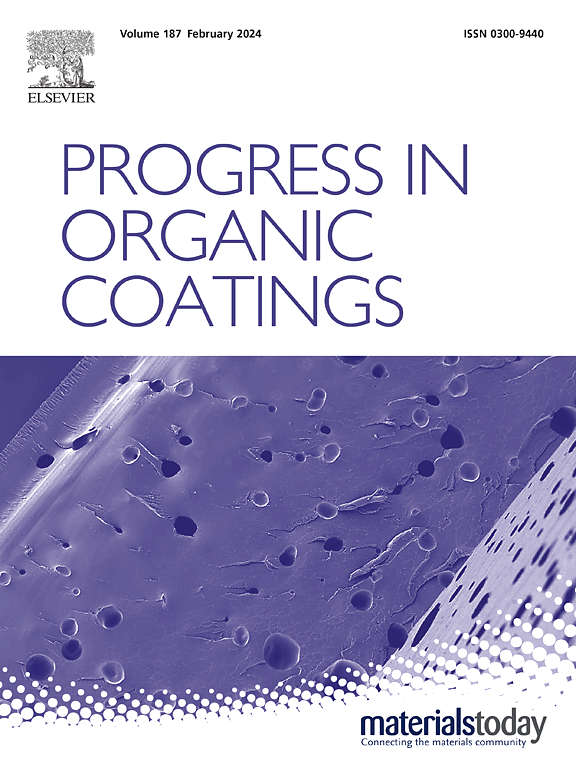Multifunctional superhydrophobic film with comprehensive icing monitoring, anti-icing, and photothermal/electrothermal deicing properties
IF 6.5
2区 材料科学
Q1 CHEMISTRY, APPLIED
引用次数: 0
Abstract
Superhydrophobic photothermal/electrothermal surfaces have garnered considerable attention on account of the synergistic effect of the superhydrophobic anti-icing and photothermal/electrothermal deicing, which can effectively address the issue of surface icing. However, it lacks the ability to precisely monitor the icing process, a critical component for improving their deicing efficiency. Therefore, a multifunctional superhydrophobic film with comprehensive icing monitoring, anti-icing, and photothermal/electrothermal deicing properties was prepared using the laser ablation method, which consisted of an interdigital patterned laser-ablated graphene (LAG) planar capacitance sensor and a laser-ablated polytetrafluoroethylene (PTFE) superhydrophobic surface. As a result, it was able to effectively monitor the process of ice growth and detect the thickness of ice by utilizing the differences in dielectric properties of water, ice, and air. In addition, the laser-ablated PTFE superhydrophobic surface processed a contact angle of 159.5° and a sliding angle of 3.5°, which prevented the ice formation for 4.9 min at −20 °C. Meanwhile, by harnessing the photothermal and electrothermal effects of the LAG conductive network, the surface temperature reached 108.4 °C and 43.2 °C with a light irradiance of 2 W/cm2 and an applied electric power density of 0.135 W/cm2, respectively, thereby allowing effective deicing. Consequently, the multifunctional superhydrophobic film, with its comprehensive icing monitoring, anti-icing, and photothermal/electrothermal deicing properties, possesses significant potential for the prevention and removal of ice.

具有综合结冰监测、防结冰、光热/电热除冰性能的多功能超疏水薄膜
超疏水光热/电热表面由于具有超疏水防冰和光热/电热除冰的协同作用,能够有效解决表面结冰问题,受到了广泛的关注。然而,它缺乏精确监测结冰过程的能力,这是提高其除冰效率的关键组成部分。因此,采用激光烧蚀方法制备了一种具有综合结冰监测、防结冰和光热/电热除冰性能的多功能超疏水薄膜,该薄膜由数字间图案激光烧蚀石墨烯(LAG)平面电容传感器和激光烧蚀聚四氟乙烯(PTFE)超疏水表面组成。因此,它能够有效地监测冰的生长过程,并通过利用水、冰和空气的介电特性的差异来检测冰的厚度。此外,激光烧蚀的PTFE超疏水表面处理的接触角为159.5°,滑动角为3.5°,在- 20°C下防止了4.9 min的结冰。同时,利用LAG导电网络的光热和电热效应,表面温度分别达到108.4°C和43.2°C,光辐照度为2 W/cm2,施加的功率密度为0.135 W/cm2,从而实现有效的除冰。因此,多功能超疏水膜具有全面的结冰监测、防结冰和光热/电热除冰性能,在防冰和除冰方面具有巨大的潜力。
本文章由计算机程序翻译,如有差异,请以英文原文为准。
求助全文
约1分钟内获得全文
求助全文
来源期刊

Progress in Organic Coatings
工程技术-材料科学:膜
CiteScore
11.40
自引率
15.20%
发文量
577
审稿时长
48 days
期刊介绍:
The aim of this international journal is to analyse and publicise the progress and current state of knowledge in the field of organic coatings and related materials. The Editors and the Editorial Board members will solicit both review and research papers from academic and industrial scientists who are actively engaged in research and development or, in the case of review papers, have extensive experience in the subject to be reviewed. Unsolicited manuscripts will be accepted if they meet the journal''s requirements. The journal publishes papers dealing with such subjects as:
• Chemical, physical and technological properties of organic coatings and related materials
• Problems and methods of preparation, manufacture and application of these materials
• Performance, testing and analysis.
 求助内容:
求助内容: 应助结果提醒方式:
应助结果提醒方式:


